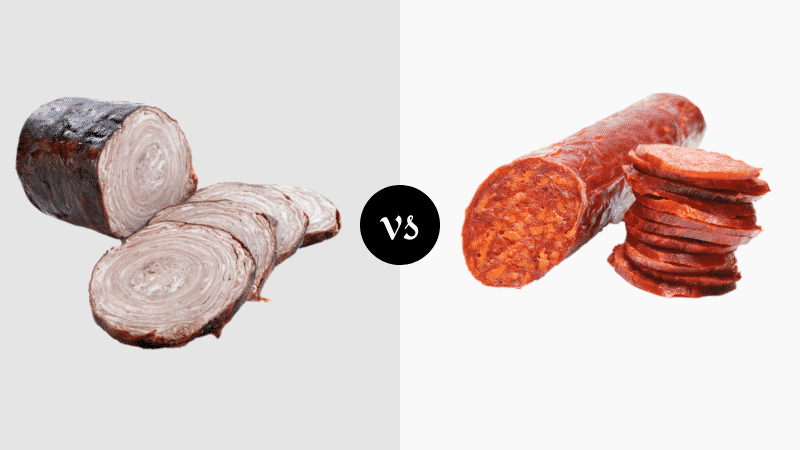
There are few sausages as tasty and delectable as pork sausages. From making the perfect topping to pizzas to making the ideal serving suggestion for breakfast – pork sausages are adored by pork lovers.
There is a wide variety of pork sausages out there waiting to be discovered, but two favorites arise out of the massive selection available.
We’ll be taking you through a look at Andouille vs chorizo, so you know the exact difference between these two popular choices.
Andouille vs Chorizo
| Andouille | chorizo | |
| Origin | France | Spain, Mexico |
| Age | 16th Century | 16th Century |
| Appearance | Dark, Grainy, Musky Red | Deep, Smokey Red |
| Ingredients | Pig Intestines, Pork Belly, Pork Shoulder, Cayenne Pepper, Filler (Onion, Garlic, Lard, Tomato, Herbs, Spices) | Ground Pork, Ground Pork Belly, Guajillo Peppers, Ancho Peppers, Paprika, Garlic, Cinnamon, Achiote |
| Flavor | Rich, Smokey, Salty, Meaty | Intense Meaty Smokiness With Prominent Spiciness And Strong, Bold Flavor Notes |
| Hotness | Mild And Savory | Hot And Spicy |
| Texture | Firm, Tender, Chewy | Firm But Melt-In-Your Mouth Tender |
| Nutrition | 170 Calories, 135 Grams Fat, 7 Grams Protein | 258 Calories, 22 Grams Fat, 14 Grams Protein |
| Serving Suggestion | Cooked Into Spicy Foods Like Gumbo & Jambalaya | Serve Sliced Or Add to Cooked Foods, Sauces, Stews, Stir-Fries And Sautés |
Andouille
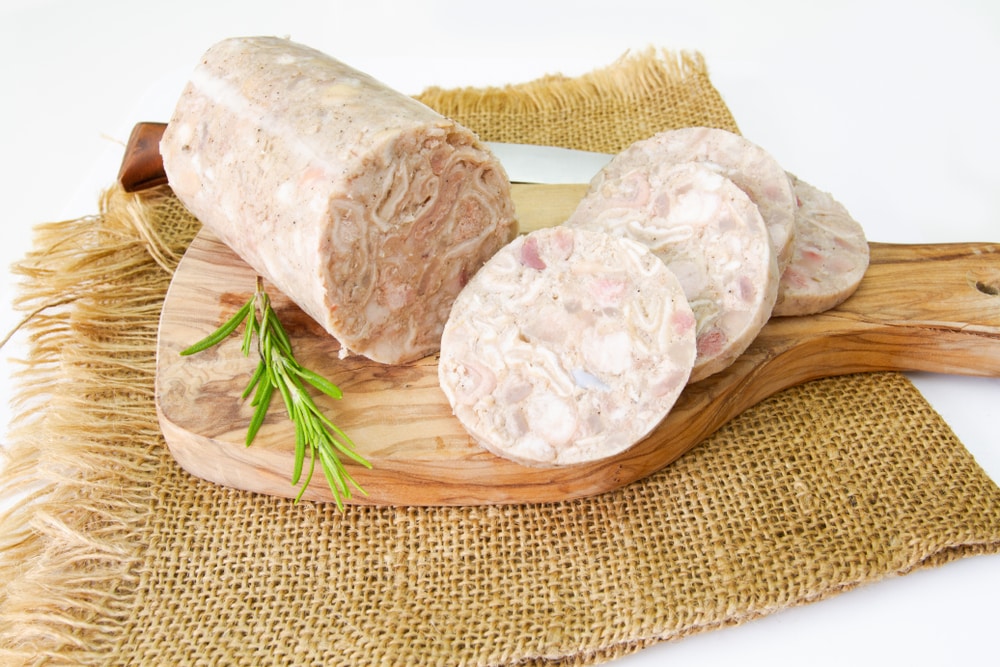
Andouille is a type of smoked sausage that’s been a favorite in many cultures since the original recipe first emerged from Guémené-Sur-Scorff, France.
The name “Andouille” refers to sausage and does not get suffixed. For example, referring to “Andouille sausage” would be a redundancy.
- Origin
Andouille originated in France and was brought to America by French immigrants and exiles who settled in southern Louisiana. It’s a favorite of Cajun cuisine and is found across Creole cooking.
From its local origins, Andouille boomed from New Orleans to availability everywhere across the world.
- Age
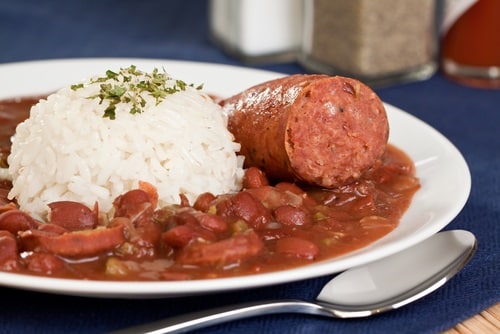
Nova Scotian immigrants began popularizing Andouille during the early 16th century when they first arrived in the South. Ever since, the sausage style remained a staple of Creole Cajun cuisine, inheriting flavor notes local to the area.
- Appearance
Andouille appears grainy and dry, carrying a dark, almost brown coloring with a deep, musky red hue. The outer casing of the sausage is known to harden and turn white after being left to dry, snapping with crunch after being cooked.
- Ingredients
What sets Andouille apart from other sausages is that it is traditionally made from all of the intestines of a single pig. The pig intestines are cleaned and seasoned with cayenne pepper and salted before being stuffed with added wine or beer.
The filling of Andouille sausage is traditionally made from a mix of a pig’s stomach and small intestine, chopped or sliced, blended with onion, garlic, lard, pork belly, or fatty shoulder, and a range of herbs, spices, and seasonings.
Outside of the Big Easy, Andouille typically also features tomatoes as part of its recipe.
- Flavor
As a cured sausage, Andouille has a vibrant, smoky flavor. It’s salty, spicy, and sharp with an unmistakable taste of its own. Anyone familiar with craft sausages will find this French classic similar but stronger and smokier.
- Hotness
Andouille has a mild degree of spiciness with a minimal burn. It’s more savory than hot.
- Texture
Andouille has a firm, coarse but tender texture. It’s chunky and dry but holds together well when slicing or biting into it. Instead of melting to mush like chorizo, Andouille holds firm with just the right degree of chewiness.
- Nutrition

A 2-ounce serving of Andouille sausage packs 170 calories, and 135 of those calories are fat while giving you 7 grams of protein at 4% of an adult’s Vitamin A and Iron intake.
- Serving Suggestion
Andouille is not normally served on its own but instead added into other dishes like gumbo or jambalaya due to the way that its rich flavor infuses into spicy meals.
You can, however, enjoy what’s affectionately known as a Cajun hot dog eating Andouille on a bun instead if preferred.
Chorizo
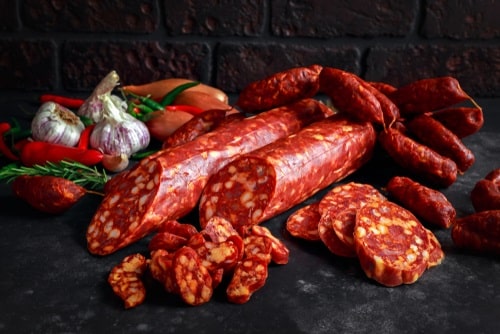
chorizo is a highly seasoned, spicy, fermented, cured, smoked sausage with an unmistakable color, taste, and texture.
- Origin
While there are many regional recipes for chorizo, the original sausage originated in Spain. A Mexican chorizo recipe was also adopted early. The first Spanish chorizo originated among the people living in the Liberian Peninsula.
Hundreds of variations on the basic, traditional recipe have arisen over the years. Portuguese varieties claim origin, whereby pig or lamb is blended and then stuffed into an intestine before being dried over smoke.
- Age
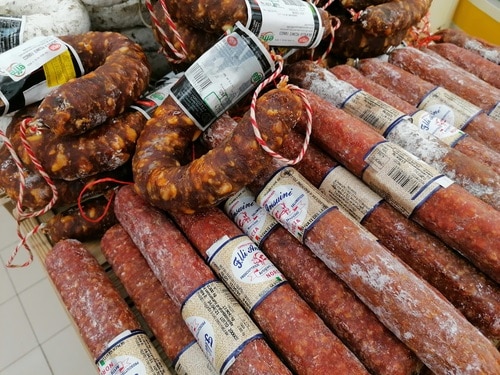
The first chorizo was created in ancient Rome, but the modern recipe that we know today originated in Spain during the early 16th century.
- Appearance
The high amounts of paprika give chorizo most of its red coloring, while other seasonings like cinnamon, peppers, and chilies also add to the deep, smokey red hue.
- Ingredients
Both fully-cooked and semi-cured chorizo are available. Mexican chorizo and Spanish chorizo have distinctly different flavors and aren’t interchangeable despite being based on the original Spanish recipe.
Spanish chorizo is made from ground pork, smoked paprika, garlic, cinnamon, achiote, and white wine, stuffed into either natural or artificial casings. The sausage is then fermented and slowly smoked before being allowed to air cure for weeks.
While recipes vary, you’ll generally find Mexican chorizo featuring meats other than pork. Vegan chorizo also normally follows a Mexican recipe.
The sausage filling is made from ground protein and extra added fat (pork belly if traditionally made) and a combination of guajillo peppers, ancho peppers, paprika, garlic, cinnamon, achiote, and a range of other herbs and spices.
- Flavor
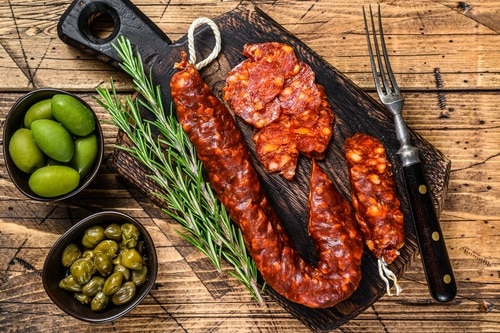
Chorizo is hot and has a far smokier flavor than andouille. The taste of hotness and notes of chili is pronounced and prominent, creating a lingering burn that offsets all other flavors.
Spiciness prevails with varying intensities of sweetness depending on the type of chorizo. Mexican chorizo is fresh, not dried. It is also hotter with no garlic used, whereas the Spanish variety is sweeter.
The other flavor difference to be on the lookout for is indicated by how the sausages are shaped. Long, thin sausages are sweeter than their short, thick counterparts.
- Hotness
Chorizo is hotter than Andouille, with a pronounced, lingering burn and prominent spicy notes that overtake other flavors.
- Texture
Both Spanish and Mexican chorizo are generally dense and fatty. Instead of chewiness, chorizo develops a soft, mushy texture that remains before and after cooking. It melts in your mouth despite being firm enough to cut.
The Spanish version is firmer due to being smoked for an extended period.
- Nutrition
Unless you’re on a ketogenic diet, chorizo isn’t the healthiest food around. It’s packed with fat, salt and high in calories. A 2 ounce serving of chorizo made from the pork will typically carry 258 calories on average with 22 grams of fat and 14 grams of protein.
Vitamin B-6 levels are high at 10%, and there are low levels of iron, magnesium, and Vitamin D.
- Serving Suggestion
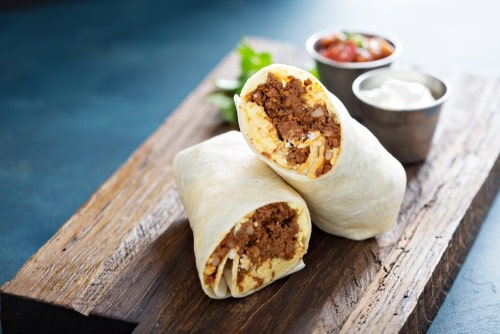
Chorizo is a very versatile sausage that you can serve sliced as-is. Alternatively, add chorizo to other meals like stews, soups, sauces, sauté’s, and stir-fries to give them a noticeable bite and bit of spice.
Remember to remove the casing if you’re adding chorizo to cooked meals for extra flavor.
Substituting Between Andouille & Chorizo
When it comes to substitutions, either sausage will work in the palace of the other in a pinch. The andouille is the most flavorsome sausage out of the two and one of the richest around, which means that it’ll be your go-to if you want to add primary flavor to a dish.
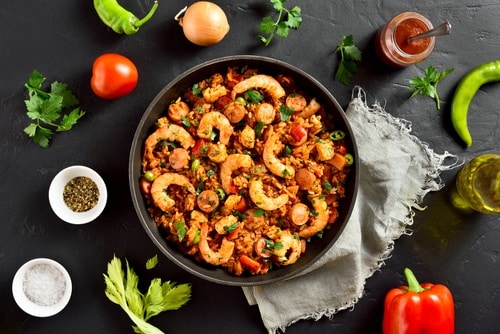
Andouille as a base works great for many stews, soups, gumbos, and jambalaya. Mexican chorizo is the closest substitute for Andouille, but Spanish will suffice. Neither Spanish nor Mexican chorizo will, however, be able to mimic the texture of Andouille.
Andouille vs Chorizo – The Bottom Line
Andouille and chorizo are both excellent options for when you feel like the taste of smoked sausage. The right sausage will depend on what you’re making. Remember that Spanish chorizo is the mildest, followed by Mexican and then the prominent, mature taste of Andouille.